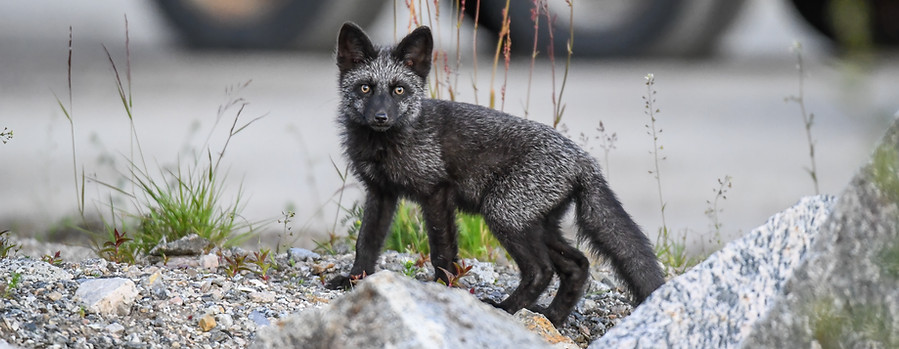
This is our archive of animals seen on our trips. We'll gradually upload pictures of species we see and a short text about the species. All pictures are taken on our tours by our guides.

Moose, Alces alces
There are a lot of moose in Vesterålen. Males weigh about 320 to 475 kg (705 to 1,047 lb) and females weigh 275 to 375 kg (606 to 827 lb) Shoulder height ranges from 1.7 to 2.1 m (5.6 to 6.9 ft)

Red Fox Vulpes vulpes
The red fox (Vulpes vulpes) is the largest of the true foxes and one of the most widely distributed predators in the world. In Vesterålen some of the red foxes has crossbred with Silver foxes giving the result that some of the foxes have different colorpatterns. Some even looks like Silver foxes or are completly black. We find dens each spring with crossbreds.

Eurasian otter, Lutra lutra
Vesterålen got a lot of otters. Its one of the hardest species to find since they have a large territory. Males and females will breed at any time of the year, making it more likely to find an active den then a lonely otter. Normally, otters are 57 to 95 cm (22.5 to 37.5 in) long, not counting a tail of 35–45 cm (14–17.5 in). The female is shorter than the male. The otter's average body weight is 7 to 12 kg (15 to 26 lb), although occasionally a large old male may reach up to 17 kg (37 lb

Tundra hare, Lepus timidus
Hares are common in Vesterålen. In the mating season in spring we can see up to 100 hares on an 4 hour tour. In mating season the hares gather on fields where the males have "boxingmatches", competing for females.
Hares grows to a length of 45–65 cm (18–26 in), with a tail of 4–8 cm (1.6–3.1 in), and a mass of 2–5.3 kg (4.4–11.7 lb), females being slightly heavier than males.

Stoat, Mustela erminea
Stoats are curious animals and often come up to people to check whats going on. On average, males measure 187–325 mm (7.4–12.8 in) in body length, while females measure 170–270 mm (6.7–10.6 in)

Reindeer, Rangifer tarandus
Reindeer in Vesterålen is semi-domestic. They live in the wild and is owned by the Sami people who heard them from winter to summer pastures and gather them each autumn.

Killer whale or orca, Orcinus orca
Orcas can be seen along the shores of Vesterålen from time to time. They move fast, but sometimes we're lucky and come over them playing or feeding. Mostly seen in december and january when the herring comes in to the fjords to spawn.

Atlantic white-sided dolphin, Lagenorhynchus acutus
One of the dolphin species that can be seen i Vesterålen. They live out on the open ocean. But occasionally come into the fjords to feed. Easy to spot as they launch themself into the air in acrobatic jumps and drive the fish against the same sandbank over and over, making them stay in the same spot for some time.

Harbor seal, Phoca vitulina
The most common species of seal in Vesterålen. Seen sunbathing on rocks all along the shoreline. Or lying on the edge of the ice in the fjords in winter. Seals are curious and walking along the shore you often can see their heads popping out of the water next to you to check whats going on.

European roe deer, Capreolus capreolus
Until 2007 there was no roe deer in Vesterålen. Now numbers are on the rise. Often seen in backyards at winter.

Photo: Herman Henriksen
American mink, Neovison vison
Common in Vesterålen. An invasive species here. Some individuals escaped from minkfarms in the 80s and 90s and bred in the wild. The farms are gone but the minks thrive.

Sperm whale, Physeter macrocephalus
Can be seen outside of Andøya all year. The spermwhales in Vesterålen are all males that migrate to breeding grounds in the south and back. The young males stay here until they are old enough to breed. Sometimes spermwhales comes into the fjords and stay there for some days. Its thought that its by accident and they uses some time before they find their way out.

Humpback whale, Megaptera novaeangliae
Humpbacks have gathered around Vesterålen at winter for years. Sometimes they follow the herring into the fjords and stay there for days. The last years the humpbacks have come in to the fjords at summer aswell.

Cross fox, Vulpes vulpes
These foxes is a cross between red and silver foxes. They tend to be less shy then red foxes.

Silver fox, Vulpes vulpes
Silver foxes escaped from fox farms in the 90's and bred with red foxes. We still see silver foxes. But then often with to cross as parents and a shorter coat. Silver foxes and black foxes are rare to see. Some dens have a mix of red, cross, black and silver foxes and can be a joy for wildlife photographers to find.
